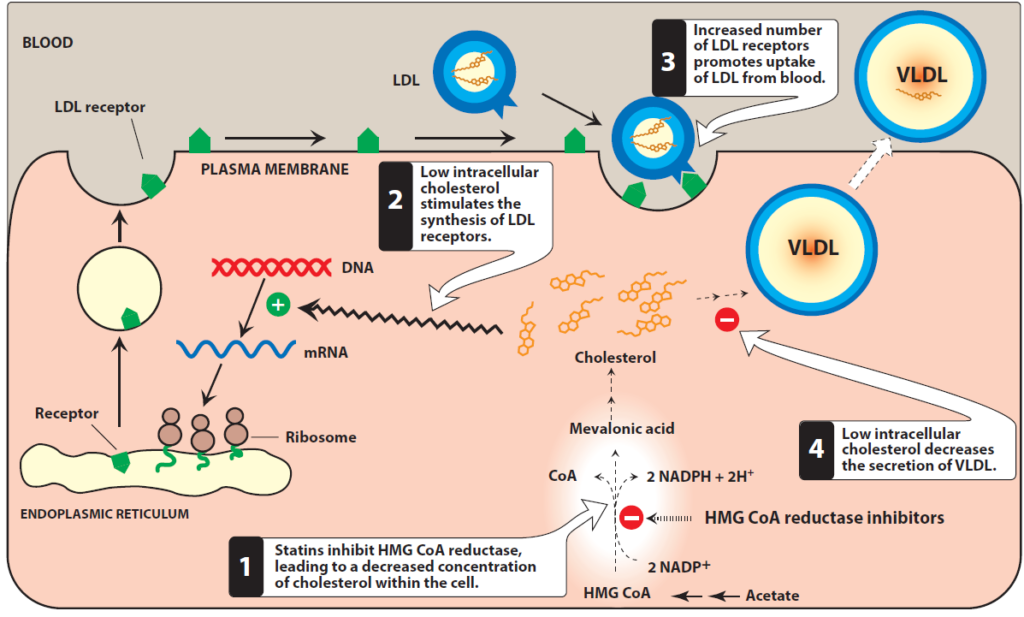
- Atorvastatin belongs to class of drug called HMG CoA reductase inhibitor or statins. Statins are lipid lowering agents and are among the most widely used drugs in cardiovascular pharmacology.
- It was approved for medical use in 1996. It is also available as generic medicine. Some other commonly used statins include pravastatin, simvastatin, Fluvastatin and lovastatin.
Indications of atorvastatin
- Used as first line treatment option for dyslipidemia. It is approved by FDA for treating different kind of dyslipidemia including:
- Hypertriglyceridemia
- Primary dysbetalipoproteinemia
- Homozygous familial hypercholesterolemia
- Pediatric patients with heterozygous familial hypercholesterolemia and
- Adult patients with heterozygous familial and non-familial hyperlipidemia and mixed dyslipidemia.
- Prescribed to reduce risk of myocardial infarction, stroke, angina, and revascularization procedures in patients without coronary heart disease but with multiple risk factors.
- Used to reduce risk of myocardial infarction and angina in patients with type 2 diabetes without coronary heart disease bit with risk factors.
- Used to reduce risk of fatal and non-fatal stroke, non-fatal myocardial ischemia in patient with coronary heart disease.
Mechanism of action of atorvastatin
- It is competitive inhibitor of HMG CoA reductase enzyme (Hydroxy Methyl Glutrayl Coenzyme A). HMG CoA reductase enzyme catalyze an early, rate-limiting step, conversion of HMG CoA to mevalonate, in cholesterol biosynthesis. Hence, it inhibits denovo synthesis of cholesterol and reduce internal supply of cholesterol.
- Atorvastatin inhibits this rate limiting step everywhere, but most important site is in the liver. As the free cholesterol content within hepatocytes is reduced, synthesis of LDL receptor increases to bind and internalize circulating LDLs to extract cholesterol from them. The decrease in cholesterol synthesis and increase in catabolism of LDL leads finally in decreased plasma cholesterol level.
- It also decreases triglyceride level and may increase HDL cholesterol level. Atorvastatin also effective in reducing total cholesterol, LDL-C (low density lipoprotein cholesterol), apolipoprotein B and VLDL-C (very low-density lipoprotein- cholesterol). It also reduces IDL-C (Intermediate Density Lipoprotein Cholesterol) in patients with dysbetalipoproteinemia.
Pharmacokinetics of atorvastatin

Figure 1- Inhibition of cholesterol synthesis by atorvastatin and other statins (Source- Lippincott’s Illustration of Pharmacology, 6th edition)
- Administered via oral route and is rapidly absorbed after oral administration. Peak plasma concentration is achieved within 1-3 hours of administration.
- It binds extensively to plasma proteins (around 98%) and it undergoes extensive first pass metabolism in liver and gut wall and hence, has very low bioavailability (14%).
- It is metabolized in liver by CYP3A4 enzymes. Metabolites of atorvastatin include ortho- and parahydroxylated derivatives and various beta oxidation products. Ortho and para hydroxylated derivatives have same action as of atorvastatin. Around 70% of inhibition of HMG CoA reductase is due to these active metabolites.
- Atorvastatin and its metabolites are mainly excreted via biliary route. Its half-life is around 14 hours and half-life of its metabolites is around 30 hours.
Adverse effects of atorvastatin
- It can cause myopathies including muscle weakness, muscle tenderness, muscle pain and rhabdomyolysis. The risk of rhabdomyolysis may increase in patient with impaired renal function. Myopathies and rhabdomyolysis can be managed by holding the therapy temporarily, reducing the dose or by switching to other statins.
- Other adverse effects include insomnia, nasopharyngitis, dyspepsia, nausea, diarrhea, and urinary tract infection. It may cause reversible rise in hepatic aminotransferase level and plasma creatine kinase level. If this rise is three times more than upper limit of normal, regular monitoring of plasma concentration is required and dose should be reduced or stopped
Drug Interactions of atorvastatin
- Concurrent administration of CYP3A4 inhibitors like cyclosporine, anti-viral agents like lopinavir and tipranavir, clarithromycin, itraconazole and voriconazole may increase plasma concentration of atorvastatin and may increase risk of side effects caused by atorvastatin including myopathy and rhabdomyolysis.
- Drug which induces CYP3A4 like rifampin may decrease plasma concentration of atorvastatin.
- Atorvastatin increases plasma concentration of digoxin and may increase drug exposure of ethinyl estradiol.
Contraindications
- Contraindicated in patients hypersensitive to atorvastatin.
- Contraindicated in pregnancy, in females who are planning for pregnancy and in nursing females.
- It is contraindicated in patient with active liver disease.
References
- https://www.ncbi.nlm.nih.gov/books/NBK430779/
- https://go.drugbank.com/drugs/DB01076
- https://www.rxlist.com/lipitor-drug.htm#interactions
- T Funatsu et al. Atorvastatin (Lipitor): a review of its pharmacological and clinical profile. Nihon Yakurigaku Zasshi. 2001 Jan; 117(1): 65-76.
- Pharmacology and Pharmacotherapeutics. 24th edition.
- Goodman and Gillman Manual of Pharmacology and Therapeutics.
- Lippincott Illustrated Reviews Pharmacology, 6th edition.